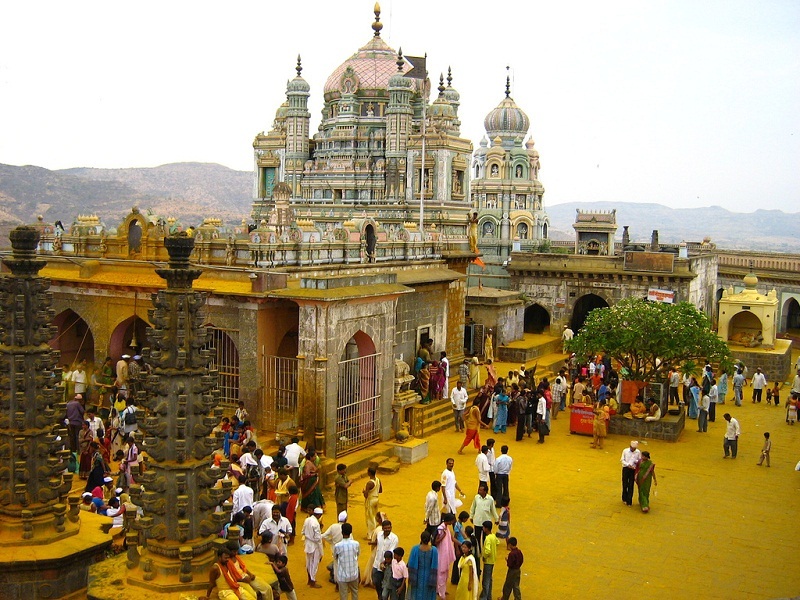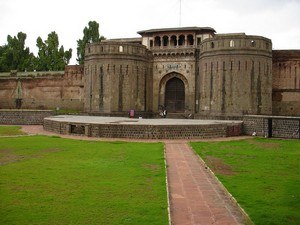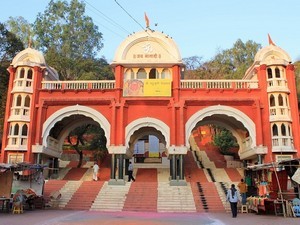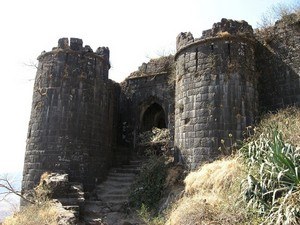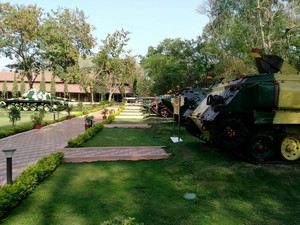Jejuri, Pune - Timings, Festivals, History, Darshan, Pooja Timings
Photo Credit: Flickr
 India | Maharashtra | Pune
India | Maharashtra | Pune
 #19 of 66 Places to Visit in Pune
#19 of 66 Places to Visit in Pune
 Distance (From Pune Railway Station): 48 Kms
Distance (From Pune Railway Station): 48 Kms
 Trip Duration (Including Travel): 3-4 Hours
Trip Duration (Including Travel): 3-4 Hours
 Transportation Options: Bus / Cab
Transportation Options: Bus / Cab
 Travel Tips: None
Travel Tips: None
About Jejuri
At a distance of 48 Km from Pune, Jejuri is a town and municipality situated to the southeast of the Pune city in Maharashtra. The town is home to the most renowned temples in Maharashtra known as Khandoba Temple dedicated to Khandoba, who is also known as Mhalsakant or Malhari Martand in the region. Khandoba is the important god worshipped by Dhangar, the oldest tribes in Maharashtra. It is believed that Khandoba is a god of Sakamabhakti, the god who fulfills all the desires of his devotees. It is one of the must-include places in the Pune family packages.
History of Jejuri
The Khandoba Temple in Jejuri dates back to the 12th and 13th centuries, with its initial construction taking place in 1608 AD. The Maratha chief Ragho Mambaji completed the hall and other structures by 1637 AD, while subsequent enhancements were made by the Holker rulers. Between 1737 and 1739, Chimaji Appa, the sibling of Peshwa Baji Rao I, donated church bells from Portuguese churches in Vasai to the temple. These bells were taken as trophies following Chimaji Appa's victory over the Portuguese in the Battle of Vasai in 1737. In 1742 AD, Tukoji Holkar contributed by adding pillars, and he finalized the battlefields and tank by 1770 AD. Additionally, shepherds who revered Khandoba as their family deity constructed staircases, lamps, cloisters, canopies, and gateways.
Mythology of Jejuri
The temple at Jejuri is considered one of the foremost centers of worship for Lord Khandoba, whose origins are intertwined with mythological narratives about Lord Shiva's incarnation to kill demons. Lord Khandoba, also referred to as Khanderaya, is revered as the Kuladevata by numerous farming families, Brahmins, and the nomadic Dhangar tribe in the Maharashtra and Deccan regions.
As per the legend, Khandoba is revered as a warrior deity who battled the demons Mani and Malla. He was supported by his two wives, Mhalsa and Banai, who are also honored alongside him in the temple. Mhalsa, the daughter of a merchant, is considered an incarnation of Goddess Parvati, while Banai, a shepherdess, is viewed as an incarnation of Goddess Ganga. Khandoba wed both women on the same day and at the same location, which is now the site of the temple.
Things to do in Jejuri
Khandoba Temple stands as the primary attraction in Jejuri, recognized as one of the most significant temples dedicated to Lord Khandoba in both Maharashtra and India. Perched atop a hill, the temple complex features two distinct shrines: the first, known as 'Kadepathar', is an ancient temple that presents a challenging ascent, requiring visitors to navigate approximately 750 steps. At this sacred site, one can find a self-manifested Linga of Lord Khandoba alongside his consort, Goddess Mhalsa. The second shrine, the more contemporary and celebrated Gad Kot temple, offers a less strenuous hike. Both temples are constructed with fort-like architecture, imparting a regal ambiance.
Elevated at 2,356 feet, the Gad Kot temple, also referred to as Jejuri gad, can be accessed via three sets of steps from the east, west, and north. The northern staircase leads directly to the temple's main entrance. This temple features around 450 steps, 18 arches, and approximately 350 Deepmalas. Enclosing the main temple is an eight-sided fort boundary that stretches 350 yards (320 meters) in length. The entrance is embellished with a large statue of Nandi.
Constructed in the Hemadpanthi architectural style, the temple comprises an outer square hall and an inner sanctum. Within the sanctum lies a linga, symbolizing Shiva, along with three pairs of images depicting Khandoba and his first wife, Mhalsa. Additionally, there is a murti of Khandoba depicted as a warrior on horseback. Worship practices for Khandoba include offerings of turmeric, belfruit leaves, and naivedhya made from onions and various vegetables. Devotees also present flowers and turmeric to the deity, often tossing turmeric into the air as a form of offering, resulting in the steps and surroundings of the hill temple being tinged with a yellow hue.
Festivals of Jejuri
The Khandoba Temple in Jejuri is renowned for hosting a variety of lively festivals, with the Bhandara Festival, often referred to as the 'Golden Festival,' and the Champa Shashthi festival being the most prominent. The Bhandara Festival features devotees tossing turmeric powder, resulting in a striking golden-yellow display. This festival is usually observed on Somvati Amavasya, a new moon day that occurs on a Monday, and draws more than five lakh visitors to the Jejuri Temple. The Champa Shashthi festival, also lasting six days, celebrates Lord Khandoba's triumph over the demons Mani and Malla each November. On the sixth day, a yatra is organized in Pember, which continues until Amavasya.
Dress Code & Other Restrictions of Jejuri Khandoba Temple
While Khandoba Temple in Jejuri, it is recommended to adhere to modest clothing that covers your upper arms and legs as a sign of respect. Men are encouraged to wear a dhoti or pajama paired with an upper garment, as well as formal trousers and shirts. Women may opt for a saree, half saree, or chudidhars. It is advisable to refrain from wearing contemporary attire such as mini-skirts, ripped jeans, shorts, and sleeveless tops while on the temple grounds.
The temple welcomes those of other faiths who visit for worship and fellowship, enriching the spiritual atmosphere.
Jejuri Khandoba Temple Timings
Monday: 6:30 AM - 12 PM & 1 PM - 8:30 PM
Tuesday: 6:30 AM - 12 PM & 1 PM - 8:30 PM
Wednesday: 6:30 AM - 12 PM & 1 PM - 8:30 PM
Thursday: 6:30 AM - 12 PM & 1 PM - 8:30 PM
Friday: 6:30 AM - 12 PM & 1 PM - 8:30 PM
Saturday: 6:30 AM - 12 PM & 1 PM - 8:30 PM
Sunday: 6:30 AM - 12 PM & 1 PM - 8:30 PM
Jejuri Khandoba Temple Entry Fee
General Entry is Free
Special Darshan available for Rs. 50
Best Time to Visit Jejuri
The optimal period to visit the Jejuri is from October to February. During these months, visitors can comfortably explore the town and enjoy sightseeing to the fullest. For those interested in experiencing local celebrations, it is recommended to plan your visit around the renowned Bhandara Festival and Champa Shashti Festival. Jejuri typically experiences mild to moderate rainfall during the rainy season, leading to increased humidity. However, this time is perfect for those who appreciate the lush greenery and vibrant landscapes that the monsoon season offers. It is advisable to avoid visiting Pune during the summer months, as the temperatures can be quite extreme.
How to Reach Jejuri
The nearest airport to Jejuri is Pune Airport which is at a distance of about 60 Km away. From Pune, one can easily reach Jejuri by using local transport services or taxi. Jejuri has its own railway station, and is connected with almost all the routes of the country. One can reach Jejuri by bus from Pune, Nashik, Matheran, Lonavala, Shirdi, and Mumbai.



